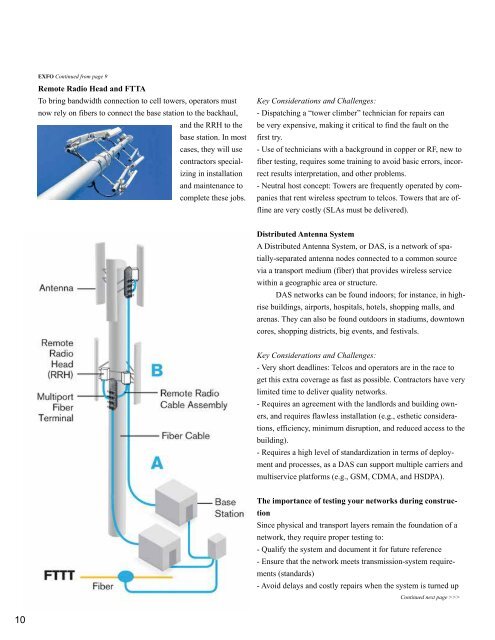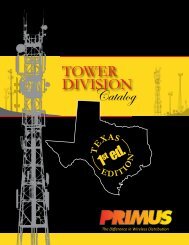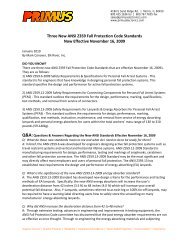3RD QUARTER 2013 - Primus Electronics Corporation
3RD QUARTER 2013 - Primus Electronics Corporation
3RD QUARTER 2013 - Primus Electronics Corporation
You also want an ePaper? Increase the reach of your titles
YUMPU automatically turns print PDFs into web optimized ePapers that Google loves.
EXFO Continued from page 9Remote Radio Head and FTTATo bring bandwidth connection to cell towers, operators mustnow rely on fibers to connect the base station to the backhaul,and the RRH to thebase station. In mostcases, they will usecontractors specializingin installationand maintenance tocomplete these jobs.Key Considerations and Challenges:- Dispatching a “tower climber” technician for repairs canbe very expensive, making it critical to find the fault on thefirst try.- Use of technicians with a background in copper or RF, new tofiber testing, requires some training to avoid basic errors, incorrectresults interpretation, and other problems.- Neutral host concept: Towers are frequently operated by companiesthat rent wireless spectrum to telcos. Towers that are offlineare very costly (SLAs must be delivered).Distributed Antenna SystemA Distributed Antenna System, or DAS, is a network of spatially-separatedantenna nodes connected to a common sourcevia a transport medium (fiber) that provides wireless servicewithin a geographic area or structure.DAS networks can be found indoors; for instance, in highrisebuildings, airports, hospitals, hotels, shopping malls, andarenas. They can also be found outdoors in stadiums, downtowncores, shopping districts, big events, and festivals.Key Considerations and Challenges:- Very short deadlines: Telcos and operators are in the race toget this extra coverage as fast as possible. Contractors have verylimited time to deliver quality networks.- Requires an agreement with the landlords and building owners,and requires flawless installation (e.g., esthetic considerations,efficiency, minimum disruption, and reduced access to thebuilding).- Requires a high level of standardization in terms of deploymentand processes, as a DAS can support multiple carriers andmultiservice platforms (e.g., GSM, CDMA, and HSDPA).The importance of testing your networks during constructionSince physical and transport layers remain the foundation of anetwork, they require proper testing to:- Qualify the system and document it for future reference- Ensure that the network meets transmission-system requirements(standards)- Avoid delays and costly repairs when the system is turned upContinued next page >>>10










